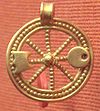| Lenus | |
|---|---|
| Healing, protection of the tribe | |
 Interior of the reconstructed temple on the Martberg, with a cult statue of Lenus Mars. Interior of the reconstructed temple on the Martberg, with a cult statue of Lenus Mars. | |
| Other names | Lenus Mars |
| Major cult center | Civitas Treverorum (current Moselle, Germany) and Venta Silurum (southeast Wales) |
| Animals | Bird (goose) |
| Gender | Male |
| Equivalents | |
| Roman | Mars |
| British | Ocelus and Vellaunus |
Lenus (Ancient Greek: Ληνός) was a Celtic god of healing, good fortune, and protection in battle, worshipped mainly in eastern Gaul, where he was almost always identified with the Roman god Mars.
Name
The Gaulish theonym Lenos has been derived from a stem lēno-, which could mean 'wood, bocage' (cf. Welsh llwyn 'bush, grave, shrub'). His name most often appears in inscriptions as "Lenus Mars", rather than "Mars Lenus" as would be expected from other most syncretized names. His name also occasionally appears as "Mars Laenus". While the bulk of religious inscriptions to Lenus Mars are in Latin, there is one Latin-Greek bilingual inscription that identifies the god as "Lēnos ... Arēs" in the Greek version.
Cult
Lenus was an important god of the Treveri, who had large sanctuaries at medicinal springs at Trier and the Martberg by Pommern in what is now Germany. Two dedications to him are also known from southwestern Britain (Chedworth and Caerwent). Edith Wightman characterizes him as “one of the best examples of a Teutates, or god of the people, equated with Mars—protector of the tribe in battle, but also bestower of health and general good fortune” (p. 211). His sanctuary "Am Irminenwingert" at Trier had a large temple, baths, smaller shrines and a theatre; that on the Martberg also included a large variety of buildings, probably including rooms for health-seeking pilgrims to stay. Notwithstanding his associations with healing, Lenus Mars is depicted classically as a warrior with Corinthian helmet in a bronze statuette from the Martberg.
At Trier, Lenus Mars's divine partners were the Celtic goddess Ancamna and the Roman Victoria, as well as the Xulsigiae, who are perhaps water nymphs. An inscription from Kaul in Luxembourg appears to invoke Lenus Mars "Veraudunus" along with the Celtic goddess Inciona.
Lenus was not the only Celtic god identified with Mars by the Treveri; others, such as Iovantucarus (apparently a protector of youth), Intarabus, Camulos, and Loucetios were identified with Mars and perhaps, by extension, with Lenus. "Lenus Mars" is accompanied by the epithets "Arterancus" and "Exsobinus" on one inscription each. The epithet "Exsobinus" has been interpreted to mean 'fearless', a name shared with the Batavian goddess Exomna.
In Britain, Lenus was identified with three other gods, namely the Roman Mars, and the British gods Ocelus and Vellaunus, as can be evidenced from the following inscription found at the base of a statue in Caerwent:
- DEO MARTI LENO SIVE OCELO VELLAVN ET NVM AVG M NONIVS ROMANVS OB IMMVNITAT COLLEGNI D D S D GLABRIONE ET HOMVLO COS X K SEPT
- To the god Mars Lenus or Ocelus Vellaunus and to the Numen of the Augustus, Marcus Nonius Romanus dedicated this from the privilege of the college during the consulship of Glabrio and Homulus ten days before the Calends of September.
Gallery
Images of Lenus and ShrinesReferences
- ^ d'Este, Sorita; Rankine, David (2007). The Isles of the Many Gods: An A-Z of the Pagan Gods & Goddesses of Ancient Britain worshipped during the First Millennium through to the Middle Ages. Avalonia. p. 173.
- ^ Edith Mary Wightman (1970). Roman Trier and the Treveri. Rupert Hart-Davis, London.
- ^ RIB 309
- ^ CIL XIII, 07661; E. Courtney (1995) reads the original dative form as Ληνῷ in Musa Lapidaria: A Selection of Latin Verses 160, p. 152. Ληνῷ agrees with dative Ἄρηι in the following line.
- Delamarre 2003, p. 435.
- Nicole Jufer & Thierry Luginbühl (2001). Les dieux gaulois : répertoire des noms de divinités celtiques connus par l'épigraphie, les textes antiques et la toponymie. Paris: Editions Errance. ISBN 2-87772-200-7.
- L'Arbre Celtique
- Musée d'histoire et d'art, Luxembourg. 1974. Pierres sculptées et inscriptions de l'époque romaine, catalogued by Eugénie Wilhelm, p.71.
- CIL XIII, 04137
- CIL XIII, 03970
- Beck, Noémie (2009). "Martial attributes: Strength, Courage and War Fury". Goddesses in Celtic Religion (PhD thesis). Université Lumière Lyon 2.
- B. Collingwood and R.P. Wright. The Roman Inscriptions of Britain. Oxford. RIB 309. Quoted at Roman-Britain.org (archived version).
Bibliography
- Delamarre, Xavier (2003). Dictionnaire de la langue gauloise: Une approche linguistique du vieux-celtique continental. Errance. ISBN 9782877723695.
External links
| Celtic mythology series | ||
|---|---|---|
| Ancient deities of Gaul, Britain and Gallaecia by region | ||
| Supra-regional |
|   |
| Britannia | ||
| Gallia Aquitania | ||
| Gallia Belgica | ||
| Gallia Celtica | ||
| Gallia Cisalpina | ||
| Gallia Narbonensis | ||
| Germania Inferior | ||
| Gallaecia | ||
